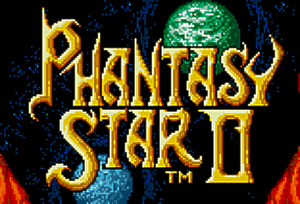
 |
|
Note: Given the importance of the storyline sequences in the Phantasy Star series, heavy spoilers are contained in our comprehensive retrospective. When released in 1989 in both Japan and the US, Phantasy Star II for the Sega Genesis was possibly the most revolutionary traditional RPG yet seen. Its gaudy box art proudly wore the '6 Mega Memory' stamp, the largest cartridge sized game at the time. Still revered by those played it in its heyday, PSII took the unique aspects of the first game in the series and pushed them even further on a 16-bit system.
Over a decade later, PSII's story remains remarkably ambitious. Its dark, sci-fi, based storyline was rare for the time and was one of the most poignant and powerful narratives crafted for a videogame. The continuing storyline takes place 1000 years after Alis of the original Phantasy Star slays the evil Lassic and Dark Force. Algo's civilization is at technological zenith, as the world, climate, farming and every aspect in the solar system is controlled by the Mother Brain supercomputer. The once desert Mota (Motavia in PS), is now dotted with domed farms, while the planet Palm (Palma) became the system's government and intellectual body and Dezo (Dezoris) remains a dark, ice shrouded mystery. The game begins with flashbacks revisiting Alis' encounter with Dark Force, ending when Phantasy Star II's protagonist, Rolf, wakes from his nightmare. Working for the government as an Agent of Mota, Rolf is given orders by his commander to find out the cause of biomonsters appearing all over the world. The playable character entourage is soon joined by Nei, a sultry siren made up of biomonster and human cells, Rudo, a professional biomonster hunter, Amy, the benevolent healer, Hugh, a serious biologist, Anna, a blonde bombshell bounty hunter, Kain, a mechanical guru, and Shir, a well-to-do thief.
The story truly begins later in the game as Rolf's group tries to normalize Mota's climate at the Climatrol. They find the first biomonster created by Mother Brain, Neifirst, who is also Nei's twin sister. The surprising reunion forces a one on one fight between the sisters, with the result standing easily as one of the most memorable scenes in RPG history, as Neifirst shockingly kills Nei, falling into Rolf's arms and uttering her last words. Her death was a significant moment for the genre and was clearly remembered later by anyone who played Final Fantasy VII. Beyond that one scene, the story is filled with intricate twists -- Rolf's heritage, the destruction of Palm, the power of the Espers, and Dark Force's purpose all come to light, though many unanswered questions surface as well. Mother Brain's demise would not be the end of the astonishing saga. As Rolf's group reaches the final destination, hundreds of Earthlings, the creators of Mother Brain, await. A battle royal between the two sides of Earth and the chosen protectors of Algo ensues and brings the story to a climactic close. The ending would remain one of the most controversial in an RPG, as the full outcome was never determined. The ending is still debated to this day by series fans.
Gameplay was another enduring legacy of Phantasy Star II. Adventure seekers will find much to explore in the prodigious overworlds of Mota and Dezo. The widely acclaimed dungeon design of the first game returned in spectacular fashion, with a much more navigable overhead view replacing the once 3D viewpoint. Dungeons were enormous and complex enough to warrant including a 100 page guidebook, but avoided becoming tedious. Of the playable cast metioned above, gamers were limited at any one time to a party of four. Characters each had their own sense of personality as well as unique attack and magic abilities, including such now-common examples as Shir being employed to steal items that can't be purchased in shops.
Graphically, Phantasy Star II was without equal. Every facet of the game is detailed and sports bright, colorful visuals. While not abundant, the stylish cut-scenes are well-used and add immensely to the game's storytelling. The music stands out in composition and quality despite the antiquated Genesis sound chip. It also fits the action perfectly, especially scores like the opening theme -- a medley now used in Phantasy Star Online's opening, the famed Nei scene, or the dramatic song in the last moments. Battles occur in a strange, high-tech blue grid. Like all the games in the series, a behind the character viewpoint is used and standard commands like fight, technique (magic), weapon, armor, defend and run are available. Though well done throughout the series, the monster design is at its best in PSII, with a wide vareity of gorgeously designed and well animated creatures. The animation is also excellent for attacks from either side.
Phantasy Star II shows its age in few ways, aside from the obvious changes in systems over the years. The translation was superlative for its day but includes minor grammatical and spelling errors. Gamers seeking to be rewarded with character interaction or comedic overtone will also be disappointed, as Phantasy Star II's approach is very direct and somewhat dour. Technology aside, it was PSII's powerful storytelling, polished gameplay, and unforgettable cast of characters that set the game apart from most any RPG. Luckily for gamers everywhere, Sega has decided to rerelease the title with other classic games in the Sega Smash Pack, and there is no better time for newcomers to explore one of the masterpieces of a bygone era. Retrospective by Jeff Davis, GIA. |
|
|||||||||||||||||||||||||||||||||||||||||||||||||





